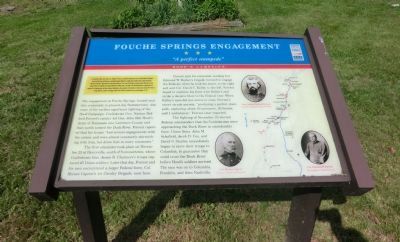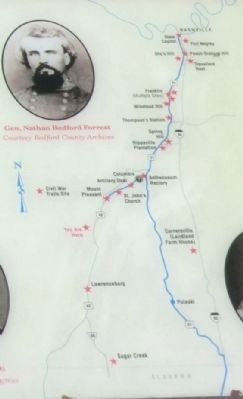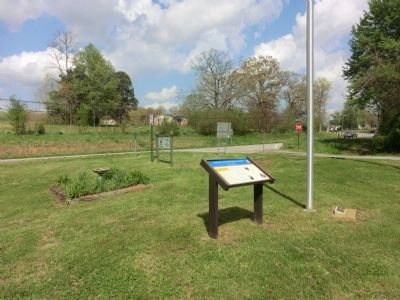Summertown in Lawrence County, Tennessee — The American South (East South Central)
Fouche Springs Engagement
"A perfect stampede"
— Hood's Campaign —
In September 1864, after Union Gen. William T. Sherman defeated Confederate Gen. John Bell Hood at Atlanta, Hood led the Army of Tennessee northwest against Sherman’s supply lines. Rather than contest Sherman’s “March to the Sea,” Hood moved north into Tennessee. Gen. John M. Schofield, detached from Sherman’s army, delayed Hood at Columbia and Spring Hill before falling back to Franklin. The bloodbath there on November 30 crippled the Confederates, but they followed Schofield to the outskirts of Nashville and Union Gen. George H. Thomas’s strong defenses. Hood’s campaign ended when Thomas crushed his army on December 15-16.
(main text)
The engagement of Fouche Springs, located near this crossroads in present-day Summertown, was some of the earliest significant fighting of the Hood Campaign. Confederate Gen. Nathan Bedford Forrest’s cavalry led Gen. John Bell Hood’s Army of Tennessee into Lawrence County and then north toward the Duck River. Forrest reported that his troops “had several engagements with the enemy, and were almost constantly skirmishing with him, but drove him in every encounter.”
The first encounter took place on November 23 at Henryville, south of Summertown, where Confederate Gen. James R. Chalmers's troops captured 45 Union soldiers. Later that day, Forrest and his men encountered a larger Federal force, Col. Horace Capron’s 1st Cavalry Brigade, near here.
Forrest split his command, sending Col. Edmund W. Rucker's brigade forward to engage the Federals while he took his escort to the right and sent Col. David C. Kelley to the left. Forrest hoped to combine his force with Kelley's and strike a decisive blow to the Federal rear. When Kelley’s men did not arrive in time, Forrest's escort struck anyway, “producing a perfect stampede, capturing about 50 prisoners, 20 horses, and 1 ambulance,” Forrest later reported.
The fighting of November 23 alerted Federal commanders that the Confederates were approaching the Duck River in considerable force. Union Gens. John M. Schofield, Jacob D. Cox, and David S. Stanley immediately began to move their troops to Columbia, to guarantee they could cross the Duck River before Hood’s soldiers arrived. The race was on to Columbia, Franklin, and then Nashville.
(captions)
(lower center) Col. Horace Capron Courtesy Library of Congress
(upper right) Gen. Nathan Bedford Forrest Courtesy Bedford County Archives
(lower right) Col. Edmund W. Rucker Birmingham Public Library
Erected by Tennessee Civil War Trails.
Topics and series. This historical marker is listed in this topic list: War, US Civil. In addition, it is included in the Tennessee Civil War Trails series list. A significant historical month for this entry is September 1864.
Location. 35° 26.112′ N, 87° 18.858′ W. Marker is in Summertown, Tennessee, in Lawrence County. Marker is at the intersection of Summertown Highway (Tennessee Route 20) and Summertown Springs Road on Summertown Highway. Touch for map. Marker is in this post office area: Summertown TN 38483, United States of America. Touch for directions.
Other nearby markers. At least 8 other markers are within 10 miles of this marker, measured as the crow flies. Lawrence County World War I Memorial (approx. 1.4 miles away); McMillan's Stand (approx. 3.4 miles away); The Bigby Greys (approx. 9.1 miles away); Mount Pleasant Confederate Memorial (approx. 9.1 miles away); Mount Pleasant Commercial Historic District (approx. 9.2 miles away); Clarke Training School (approx. 9.2 miles away); Breckenridge Hatter's Shop (approx. 9.2 miles away); Highland Hall (approx. 9.3 miles away). Touch for a list and map of all markers in Summertown.
Credits. This page was last revised on June 16, 2016. It was originally submitted on July 3, 2014, by Don Morfe of Baltimore, Maryland. This page has been viewed 1,059 times since then and 86 times this year. Photos: 1, 2, 3. submitted on July 3, 2014, by Don Morfe of Baltimore, Maryland. • Bernard Fisher was the editor who published this page.


